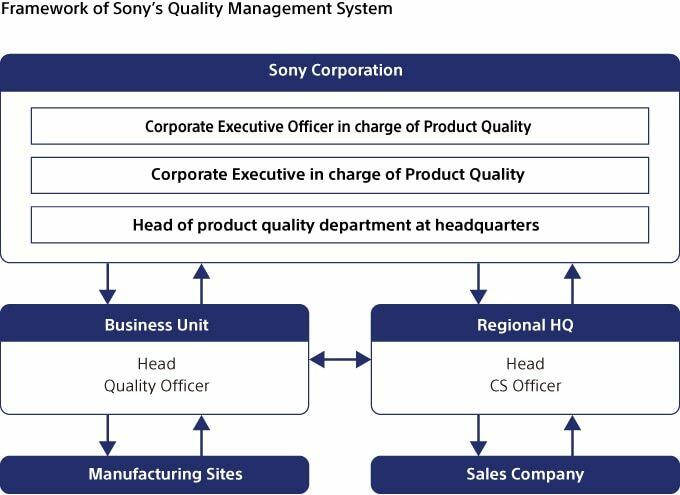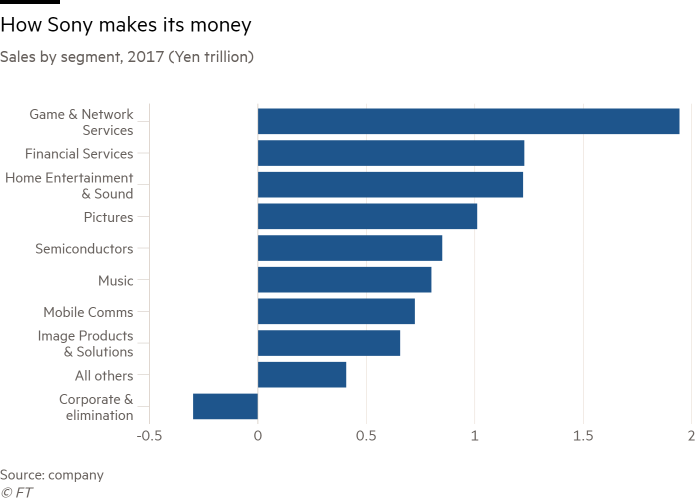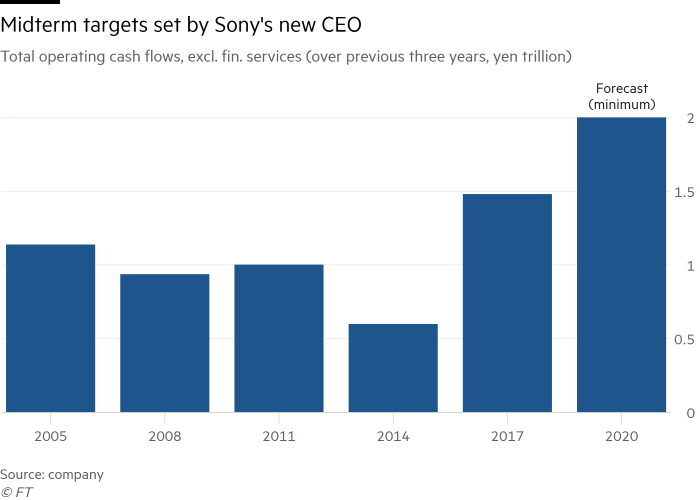Introduction
Sony is a Japan-based international corporation that produces electronics and provides entertainment and financial services. Established in 1946 by Akio Morita and Masaru Ibuka, it succeeded as a part of Sony Groups that also includes Sony Pictures, Sony Music, Sony Interactive Entertainment, et cetera (Green, 2017). While the performance of Sony began in Tokyo, it covers a lot of countries worldwide today due to the opportunities provided by globalization processes.
In order to remain competitive, the company forms joint ventures, sells its activities, and restructures the branches and divisions. The chairman, Kaz Hirai, and President and CEO, Kenichiro Yoshida, are the two main people who identify the company’s course of development. The ownership structure consists of institutional holdings allocated to holders, who cannot lead the company, yet Yoshida and Hirai should respond to them about their actions.
This paper will focus on how Yoshida took a new perspective on leading the company and making it successful based on the range of the previous solutions regarding the company’s strategy. This CEO freed Sony from the production of Vaio laptops and returned the corporation to profitability (Inagaki & Barber, 2018). It should be stressed that Yoshida is not a traditional Japanese leader since contrary to all widely accepted strategies, he criticizes the previous management of the company for not adapting Sony to the changing electronics market.
In particular, the paper will discuss why such strategies as focus on innovations and content prioritization were declared by Yoshida as the key components of the integral decision. Currently, one may observe the first positive results of the mentioned solution, which are evident through reduced costs and increased interest of customers and partners. More to the point, the stakeholders tend to support this decision due to its consistency with the contemporary market development trends.
The structure of the essay is organized chronologically to follow the factors that contributed to the target solution. First of all, the way Sony was introduced will be examined to understand its initial mission. Second, it seems also essential to determine the external environment factors that promoted the decision of Yoshida, which will be conducted in the context of the stakeholder theory, focusing on the connection with the interested parties and taking their needs and expectations into account. Third, the internal environment will be analyzed based on the constructs of the institutional theory. The social and cultural aspects that played a decisive role in the historical success of the company are to be identified and interpreted. Ultimately, the concluding part will summarise the key points and answer the question of how Sony adopted the identified solution.
Factors that Affected Yoshida’s Decision
Early Steps and the Raise of Sony
Sony created the transistor radio after World War II, which soon was spread across the globe due to its popularity. The leadership of Akio Morita allowed the company to remain ahead of technological progress, and its leaders devoted most of their work to come up with ways to utilize the achievements for the benefit of all people. Inspired by the idea of creating new markets, Sony played the role of a pioneer and occupied the leading position in the sector of consumer electronics (Frynas & Mellahi, 2015).
There are few technology companies that have a comparable success story. At this period, the company’s management used about 85 percent of the time to the issues associated with research and development, 10 percent to staff, and only the remaining 5 percent to finance (Frynas & Mellahi, 2015). For Akio Morita, the financial results were the results of hard work on the creation of new products and the formation of new markets. It was believed that in case Sony handled well with its main task, the results will be consistent. Thus, it is clear that the initial developmental course taken by Morita and Ibuka was closely associated with innovations, which were given much less attention in the future years.
External Environment Factors
One of the key persons who affected the target decision was Edward Deming. The prominent Japanese quality control system was introduced by this expert who was not known in his own country until his ideas of quality control had such a huge impact on Sony. The Americans realized the significance of the statements of this scholar but did not treat them with the same seriousness as the Japanese. In fact, the Deming Prize for quality is one of the highest awards that a Japanese company can receive. In the 1950s, Deming persuaded the leaders of the company to concentrate on producing goods faster, better, and cheaper – he promoted the ideas of industrialization (Kar, 2017). In other words, the initiative of the rapid and massive increase in production was declared pivotal. The higher the quality of the product, the fewer maintenance problems will occur. It should be stated that all of the discussed events and actions occurred in the headquarters of Sony – Tokyo, Japan.
The review of the relevant sources shows that such obsession improved quality yet left the leaders of Japanese business with fewer skills to develop and apply innovation in any other field. Over time, Sony tended to pay less attention to the development of industrial products, forgetting the idea to create new markets (Moskowitz, 2016). For example, even though Vaio computers were of exceptional quality, they almost did not use new technologies. When the company had to get involved in severe competition with, HP, Dell, and Lenovo, its success began to depend on the game to reduce the cost/price of the production of computers, but not on the development of new designs. One should point out the fact that Sony has deliberately developed a clearly industrialized strategy focused on the processes and production volumes, instead of trying to create something unique.
In 2012, led by Stringer, Sony has entered into a partnership with Ericsson, subsequently buying it entirely (Noam, 2018). Again, customers did not observe any new technologies or attempts to create a device that stands out from the rivals. Instead, Sony has focused on increasing the volume of production along with the circumvention of the products of Nokia, Motorola, and Samsung with regard to price and functionality (Merrin, 2017). With no consumer or technological advantage, Samsung left Sony with its industrial strategy far behind due to lower costs. This shows that the preference was given to volumes intentionally as a way to maximize profit and saturate the market.
According to the stakeholder theory, a company is not only economic integrity and a tool for making a profit but also an element of the environment in which it operates. Namely, it is a system that influences and is influenced by its environment, including local communities, consumers, suppliers, public organizations, staff, investors, and shareholders (Freeman & Moutchnik, 2013). The first method of the identified theory that is used by Sony is to establish partnerships with stakeholders (Fernando & Lawrence, 2014). An important goal of this method is to build such relationships so that it is more profitable for the stakeholder to act in the interests of the company since in this case it also reaches its own interests. Yoshida considers that Sony should make better use of its user data in order to create content that best suits their preferences (Kodama & Shibata, 2015). This proximity to users is regarded as the way to survive. Therefore, Sony will not close PlayStation Vou, the Internet streaming television service.
In the context of the stakeholder theory, the concept of shared values can be defined as policies and operational practices that enhance the competitiveness of a particular company (Hörisch, Freeman, & Schaltegger, 2014). At the same time, it strives to improve the economic and social conditions of related communities. Creating shared values focuses specifically on situational identification as well as expanding and strengthening the links between social and economic progress (Kodama & Shibata, 2015). Since previously the volume and price reduction were the main goals, innovations lacked necessary attention purposefully as they were not assigned a top priority.
Today, Yoshida attempts to preserve its quality and introduce innovations to build a business around communities of interest arising among gamers, film fans, and music lovers (Figure 1 shows that quality remains essential for Sony). For instance, the largest community is the Sony PlayStation Network. The CEO believes that the data on 80 million players need to be better analyzed in order to create content that best matches the interests of the audience (Thilk, 2018). A recent example of such a hit is the success of the new Spider-Man for the PlayStation 4, which was released on September 7 and for three days sold a record circulation of 3.3 million copies. By approximate calculations, Spider-Verse film collected $30-35 million (Thilk, 2018). Thus, it is evident that the decision to target customers was dictated by the need to better understand what they need and adjust innovations accordingly.

Internal Environment Factors
The institutional theory of organizations implies that they are social structures with a certain degree of resilience. There are social, cultural, cognitive, and regulative components of the theory that specify how one or another decision was taken. It should be emphasized that the main insight of the institutional theory refers to imitation as organizations tend to look at their competitors to make solutions instead of practicing a rational approach. Overall, cultural and cognitive explanations are most appropriate to understand Sony’s decision. In consistent with this theory, Yoshida observed other companies and found that such giants as Apple or Google always target innovations and adjustment of their products. Partially, the CEO focused on his decision since the company was lacking for many years.
In 2016, headed by Kazuo Hirai, an ex-CEO, Sony entered the new frontier of competitiveness by launching Blu-Ray technology to the market, its strategy remained the same. First of all, it aimed at finding a way to sell as many devices as possible working in a new format (Pope, 2012). Therefore, the company did not sell Blu-Ray technology to anyone. Similarly, it behaved in the market of audio files by developing its own audio encoding format that was applicable only to devices manufactured by Sony. In the conditions of the information economy, this approach could not suit consumers, and Blu-Ray turned out to be an unprofitable undertaking, uninteresting to the market, and the same fate awaited the now closed series of digital Sony players (Pope, 2012).
One may observe such a situation in almost all areas of the company’s business. For example, in the production of televisions, Sony has lost its technological advantage that was achieved due to the launch of Trinitron CRT. In the segment of flat-panel devices, Sony applied its industrial strategy, trying to beat the competition by increasing volumes and reducing costs with predictably dismal results.
The situation started to change before Yoshida – under the leadership of Morita in the 1990s, the development of new products was at the forefront, and the tactics of the industrial age were used to reduce costs. However, Sony executive, Stringer who came to the company in 2009 was trained differently: to implement an industrial strategy. In his perspective, new products and markets occupied a subordinate place. They were convinced that if Sony would have sufficiently high gross figures and would be able to sufficiently reduce costs, sooner or later the victory in the competition would be ensured to it.
By 2010, Sony had reached the climax of this strategy, putting the company at the head of a non-Japanese leader (Dhillon & Gupta, 2015). Stringer earned his reputation as the head of Sony’s American subsidiary, who, in perfect agreement with the letter of the industrial strategy, reduced the 30,000-strong staff of the company to 9,000 (Hartung, 2012). For Stringer, Sony’s mainstream development course was neither innovation, nor technology, nor new products and markets.
In Stringer’s version, an industrial strategy meant obsession with cost reduction. While Morita’s management meetings were 85 percent dedicated to innovation and market-based technology, Stringer brought a modern approach to Sony (Velez-Castrillon & Angert, 2015). It should be stressed that Sony’s leadership was driven in strict accordance with MBA success recipes of the 1960s. By focusing on a specific limited range of products to increase production volumes and trying to avoid the costly development of technological innovations in favor of mass production, he strived to achieve the reduction of costs. The increase in the service life of the product and equipment was also dictated by MBA value systems of that time (Velez-Castrillon & Angert, 2015). That is why during Stringer’s short stay at the head of Sony, the company did not create a single new product.
In 2012, when Kazuo Hirai replaced Stringer as the CEO of Sony, the corporation suffered losses for four years in a row. However, competing in costs with countries where labor is cheaper than Japanese, Sony turned out to be daunting, and Forbs called people to sell stocks of Sony, yet it proved to be wrong (Hartung, 2012). Hirai returned Yoshida to Sony and made him a finance director. In 2012–2018, Sony’s shares have risen in price three times, and the corporation has returned to the top ten most expensive companies in Japan. The operating profit for the 2017/18 fiscal year increased 2.5 times to a record 734.9 billion yen ($ 6.72 billion) (Inagaki, 2017). This shows that the decision to employ innovations as the driving force of future actions is effective. In terms of the institutional theory, the previous leaders of the company tried to use traditional and industrial strategies that now seem to be outdated.
As it can be viewed from the provided above analysis, all the actions initiated by Sony leaders were deliberate and planned. The key factors were associated with the social and cultural constructs that specified their actions and beliefs. It is noteworthy that Yoshida’s approach to innovations is caused by his commitment to the Japanese approach to exceptional quality and also by his creative application of the global production culture inspired by new technology (Graph 1 and Graph 2).


A vivid example of the need for internal cooperation is the project of a self-driving car, which is engaged by a group of Sony engineers who previously developed smartphones. Yoshida assures that this project was not started up for the sake of creating a car but to evoke passion in employees and keep talents (Nakamura, 2019). In addition, Sony would like to occupy a niche manufacturer of entertainment systems for cars and supplier of image sensors (Iwato, 2018). The production of the latter sharply increased after the appearance of the trend for smartphones with two cameras.
Conclusion
To conclude, this paper explored the factors that led the current CEO and President of Sony to take the decision that focuses on innovations, content prioritization, and the stop in the production of Vaio computers. Based on the chronologic presentation of the events, it was revealed that the Japanese brand became interested in reducing costs and increasing production volumes while the development of new technologies was not considered important. Even though such an approach was effective for the 20th century, it seems to be outdated today. The mentioned statement identifies the key reason for the target decision that allowed Sony to survive the crisis and become successful again.
References
Dhillon, I., & Gupta, S. (2015). Organizational restructuring and collaborative creativity: The case of Microsoft and Sony. IUP Journal of Business Strategy, 12(1), 53-65.
Fernando, S., & Lawrence, S. (2014). A theoretical framework for CSR practices: Integrating legitimacy theory, stakeholder theory and institutional theory. Journal of Theoretical Accounting Research, 10(1), 149-178.
Freeman, E., & Moutchnik, A. (2013). Stakeholder management and CSR: Questions and answers. uwf UmweltWirtschaftsForum, 21(1-2), 5-9.
Frynas, J. G., & Mellahi, K. (2015). Global strategic management (3rd ed.). New York, NY: Oxford University Press, USA.
Green, S. (2017). Sony. Minneapolis, MN: Bellwether Media.
Hartung, A. (2012). Sayonara Sony: How industrial, MBA-style leadership killed a once great company.Forbes. Web.
Hörisch, J., Freeman, R. E., & Schaltegger, S. (2014). Applying stakeholder theory in sustainability management: Links, similarities, dissimilarities, and a conceptual framework. Organization & Environment, 27(4), 328-346.
Inagaki, K. (2017). Sony forecasts its highest profits in 20 years.Financial Times. Web.
Inagaki, K., & Barber, L. (2018). Sony chief vows recovery is no false dawn.Financial Times. Web.
Iwato, H. (2018). New Sony chief sets goals beyond the horizon.Nikkei Asian Review. Web.
Kar, S. (2017). Total quality management and its applications for business growth. Globsyn Management Journal, 11(1/2), 55-58.
Kodama, F., & Shibata, T. (2015). Demand articulation in the open-innovation paradigm. Journal of Open Innovation: Technology, Market, and Complexity, 1(1), 2-23.
Merrin, S. (2017). The power of positive destruction: How to turn a business idea into a revolution. Hoboken, NJ: John Wiley & Sons.
Moskowitz, S. L. (2016). Advanced materials innovation: Managing global technology in the 21st century. New York, NY: John Wiley & Sons.
Nakamura, Y. (2019). Sony opens up internal startup program to anyone with an idea.Bloomberg. Web.
Noam, E. M. (2018). Managing media and digital organizations. New York, NY: Palgrave Macmillan.
Pope, S. (2012). Sony’s blues caused By Blu-ray.Forbes. Web.
Sustainability reporting. (2018). Web.
Thilk, C. (2018). Sony’s focus on diversity in ‘Spider-Verse’ marketing reanimates Spider-Man.The Hollywood Reporter. Web.
Velez-Castrillon, S., & Angert, C. (2015). How Sony got its groove back: A case study in turnaround management. Business Education Innovation Journal, 7(2), 144-154.